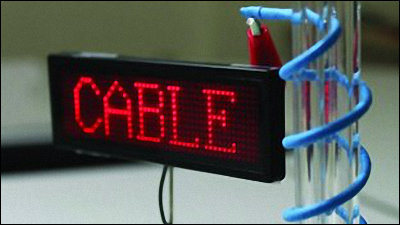The results of thorough verification of popular theories about AA alkaline batteries such as 'disposable batteries have higher performance than rechargeable batteries' and 'AA batteries last longer as they are heavier' are now available.

Many people have had the experience of wondering which one to buy when trying to buy a battery at a mass retailer or online shop. Alkaline batteries can maintain stable voltage and current for a longer period of time than manganese batteries, so AA alkaline batteries with general standards are the power source for a wide range of products such as flashlights, portable audio equipment, toys and game controllers. It has become. Therefore, experts in photovoltaic power generation and electrical appliances actually measured the performance of various AA alkaline batteries and rechargeable batteries on the market and released the analysis results.
Great AA Alkaline Battery Test – Pt 1: Battery Testing Fundamentals | Gough's Tech Zone
Great AA Alkaline Battery Test – Pt 2: The Contenders | Gough's Tech Zone
https://goughlui.com/2016/12/19/great-aa-alkaline-battery-test-pt-2-the-contenders/
Great AA Alkaline Battery Test – Pt 3: The Results | Gough's Tech Zone
https://goughlui.com/2016/12/19/great-aa-alkaline-battery-test-pt-3-the-results/
According to Gough Lui, who studies engineering at Western Sydney University in Australia, the performance of batteries varies widely even if they are called batteries. For example, in the case of capacity, it means that 'a battery with a capacity of 1000mAh and a voltage of 1.5V and a battery with a capacity of 500mAh and 3V have the same energy', so if the capacity value is large, it does not mean high performance. You can grasp the amount of power of the battery by multiplying the current and the voltage to calculate the 'milliwatt hour (mWh)', but since the nominal voltage fluctuates greatly depending on the conditions such as temperature, only the manufacturer's information and simple measurement Then, it seems that it is not possible to know the power of the battery.
Therefore, Mr. Lui conducted an experiment to measure and compare commercially available AA batteries from one end under the following conditions.
・ Set the room temperature to 21 degrees with the air conditioner
・ Uses AWG 16 wire to prevent errors due to voltage drop.
・ Measured with B & K Precision Model 8600 , a power tester that has been reviewed and confirmed for reliability.
・ Measured under 0.48W conditions assuming the same '400mA discharge in 5 hours' as a general 2000mAh 1.2V nickel-metal hydride battery
・ Test ends at 0.8V, which is the lower limit of the voltage required by general devices.

For the test, we used 181 batteries of 47 types and a total weight of 4.26 kg that Mr. Lui obtained. The cost was about A $ 350 (about 29,000 yen) for the battery alone, and the total test time was 556 hours.
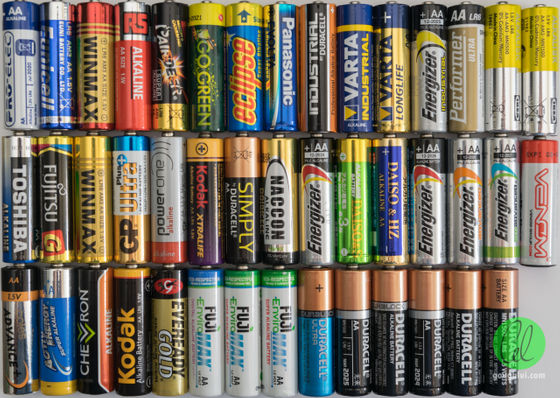
And the following is a summary of the test results. Click the image to see the original size image (348KB), or
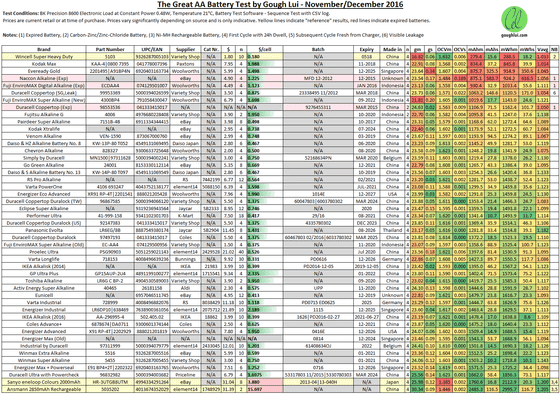
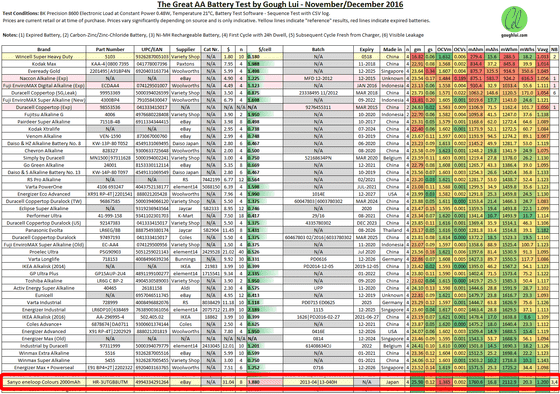
From this, Mr. Lui said, 'Nickel-metal hydride rechargeable batteries outperformed all alkaline batteries. The result is that some of them continue to use alkaline batteries, believing that they have high energy density under high load. It is a betrayal of the people's claims, 'he said, pointing out that the results were contrary to the myth that rechargeable batteries perform worse than disposable batteries.
Other than the rechargeable battery, the one that showed the best performance was the Duracell Ultra with a power check. The following is a table showing the upper and lower limits of the milliwatt hour readings, which means that the one to the right is better.
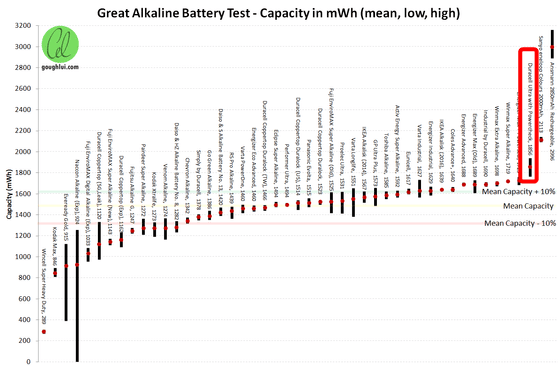
In addition, there is a myth about batteries that 'the heavier the battery, the better the performance because it is packed with more materials.' Therefore, the graph created by adding the weight (horizontal axis) to the measurement result (vertical axis) at milliwatt hours is as follows. The result is that there is some correlation, although there is considerable variability.
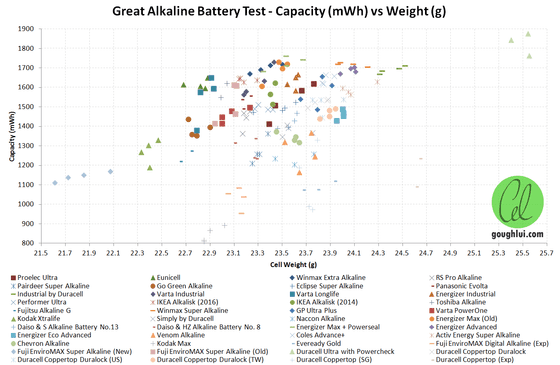
Regarding the relationship between weight and battery performance, Mr. Lui said, 'AA batteries are light in the first place, so the weight depends on the package used by each manufacturer. Therefore, weigh the battery at the store. It's not a good idea to find out which one is the best, but it's possible that heavier batteries have more content and better performance, as batteries from the same manufacturer don't have to consider those factors. ' I have commented. In addition, Mr. Lui himself brought a weight scale to the supermarket when he was a child, weighed the battery, and the clerk had a strange face.
Similarly, the results of verifying the myth that 'batteries with longer expiration dates are better' by taking milliwatt hours (vertical axis) and expiration date (horizontal axis) are as follows. Regarding this, Lui said, 'If you plot the capacity and expiration date of all brands of batteries, it seems that there is a weak but slight correlation, but the expiration date is 3 to 12 years depending on the manufacturer. The fluctuation range is large, and the technology used for batteries differs from manufacturer to manufacturer, so it cannot be said that there is a clear relationship. '
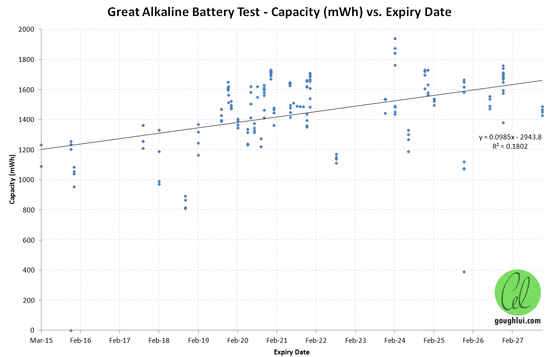
Lui also summarized the findings from the entire study: 'When used at a load of 0.48W, rechargeable nickel-metal hydride batteries outperformed all alkaline batteries tested to maintain voltage. It is also excellent and costs less than disposable batteries. Other than rechargeable batteries, Duracell Ultra has won the seat of the battery with the highest capacity. Also, the average discharge voltage of alkaline batteries is one of the best. It was similar except for Panasonic's Evolta . In addition, we found that weight is a predictor of capacity only if the batteries are from the same manufacturer, while expiration dates are compared between the same brands. Anyway, if you're from a different manufacturer, you can't find a clear relationship with capacity. '
Related Posts:
in Note, Posted by log1l_ks






